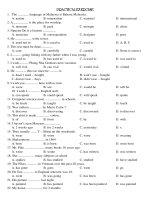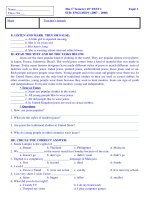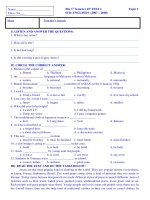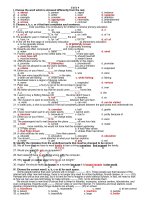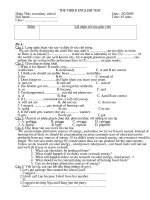Physics section test (9)
Bạn đang xem bản rút gọn của tài liệu. Xem và tải ngay bản đầy đủ của tài liệu tại đây (982.35 KB, 12 trang )
MCAT Section Tests
Dear Future Doctor,
The following Section Test and explanations should be used to practice and to assess
your mastery of critical thinking in each of the section areas. Topics are confluent and
are not necessarily in any specific order or fixed proportion. This is the level of
integration in your preparation that collects what you have learned in the Kaplan
classroom and synthesizes your knowledge with your critical thinking.
Simply
completing the tests is inadequate; a solid understanding of your performance through
your Score Reports and the explanations is necessary to diagnose your specific
weaknesses and address them before Test Day.
All rights are reserved pursuant to the copyright laws and the contract clause in your
enrollment agreement and as printed below. Misdemeanor and felony infractions can
severely limit your ability to be accepted to a medical program and a conviction can
result in the removal of a medical license. We offer this material for your practice in your
own home as a courtesy and privilege. Practice today so that you can perform on test
day; this material was designed to give you every advantage on the MCAT and we wish
you the best of luck in your preparation.
Sincerely,
Albert Chen
Executive Director, Pre-Health Research and Development
Kaplan Test Prep
© 2003 Kaplan, Inc.
All rights reserved. No part of this book may be reproduced in any form, by Photostat, microfilm,
xerography or any other means, or incorporated into any information retrieval system, electronic
or mechanical without the written permission of Kaplan, Inc. This book may not be duplicated,
distributed or resold, pursuant to the terms of your Kaplan Enrollment Agreement.
Physical Sciences
Test 5
Time: 39 Minutes
Number of Questions: 30
MCAT
PHYSICAL SCIENCES
DIRECTIONS: Most of the questions in the following
Physical Sciences test are organized into groups, with
a descriptive passage preceding each group of
questions. Study the passage, then select the single
best answer to each question in the group. Some of
the questions are not based on a descriptive passage;
you must also select the best answer to these
questions. If you are unsure of the best answer,
eliminate the choices that you know are incorrect,
then select an answer from the choices that remain.
Indicate your selection by blackening the
corresponding circle on your answer sheet. A periodic
table is provided below for your use with the
questions.
PERIODIC TABLE OF THE ELEMENTS
1
H
1.0
2
He
4.0
3
Li
6.9
4
Be
9.0
5
B
10.8
6
C
12.0
7
N
14.0
8
O
16.0
9
F
19.0
10
Ne
20.2
11
Na
23.0
12
Mg
24.3
13
Al
27.0
14
Si
28.1
15
P
31.0
16
S
32.1
17
Cl
35.5
18
Ar
39.9
19
K
39.1
20
Ca
40.1
21
Sc
45.0
22
Ti
47.9
23
V
50.9
24
Cr
52.0
25
Mn
54.9
26
Fe
55.8
27
Co
58.9
28
Ni
58.7
29
Cu
63.5
30
Zn
65.4
31
Ga
69.7
32
Ge
72.6
33
As
74.9
34
Se
79.0
35
Br
79.9
36
Kr
83.8
37
Rb
85.5
38
Sr
87.6
39
Y
88.9
40
Zr
91.2
41
Nb
92.9
42
Mo
95.9
43
Tc
(98)
44
Ru
101.1
45
Rh
102.9
46
Pd
106.4
47
Ag
107.9
48
Cd
112.4
49
In
114.8
50
Sn
118.7
51
Sb
121.8
52
Te
127.6
53
I
126.9
54
Xe
131.3
55
Cs
132.9
56
Ba
137.3
57
La *
138.9
72
Hf
178.5
73
Ta
180.9
74
W
183.9
75
Re
186.2
76
Os
190.2
77
Ir
192.2
78
Pt
195.1
79
Au
197.0
80
Hg
200.6
81
Tl
204.4
82
Pb
207.2
83
Bi
209.0
84
Po
(209)
85
At
(210)
86
Rn
(222)
87
Fr
(223)
88
Ra
226.0
89
Ac †
227.0
104
Unq
(261)
105
Unp
(262)
106
Unh
(263)
107
Uns
(262)
108
Uno
(265)
109
Une
(267)
*
58
Ce
140.1
59
Pr
140.9
60
Nd
144.2
61
Pm
(145)
62
Sm
150.4
63
Eu
152.0
64
Gd
157.3
65
Tb
158.9
66
Dy
162.5
67
Ho
164.9
68
Er
167.3
69
Tm
168.9
70
Yb
173.0
71
Lu
175.0
†
90
Th
232.0
91
Pa
(231)
92
U
238.0
93
Np
(237)
94
Pu
(244)
95
Am
(243)
96
Cm
(247)
97
Bk
(247)
98
Cf
(251)
99
Es
(252)
100
Fm
(257)
101
Md
(258)
102
No
(259)
103
Lr
(260)
GO ON TO THE NEXT PAGE.
2
as developed by
Physical Sciences 5
B. Heat is removed from the filament.
C. The bulb is less likely to implode when
subjected to vibration.
D. The gas directly absorbs energy from the
electrons in the filament.
Passage I (Questions 1–5)
With the recent interest in the effect of light on
mood, a market has developed for lamps that simulate
the spectrum of outdoor light. The natural light
spectrum on a sunny day is of more or less equal
intensity over the range from 540 to 700 nanometers,
although the intensity is lower at shorter wavelengths,
particularly from about 400 to 460 nanometers. On a
cloudy day, the greatest natural light intensity occurs
on the blue end of the spectrum, with the red end
somewhat less intense. Of course, the greatest
difference between the artificial light generally used in
homes and natural light is the intensity.
Why does an incandescent light have a longer life
when an inert gas is used rather than a vacuum?
C.
intensity
intensity
A.
400 nm
B.
400 nm
3.
λ
700 nm
4.
400 nm
D.
700 nm
λ
λ
700 nm
400 nm
λ
700 nm
Which kind of lamp can produce excess exposure
to ultraviolet radiation when operating normally?
A.
B.
C.
D.
Incandescent lamps only
Fluorescent lamps only
Both incandescent and fluorescent lamps
Neither kind of lamp
Which kind of lamp, incandescent or fluorescent,
is more efficient?
A. Incandescent lamps, because they convert all
of the electrical energy to visible light.
B. Fluorescent lamps, because they produce
radiation in the visible range and very little
heat.
C. Incandescent lamps, because no energy is lost
in the conversion from one wavelength to
another.
D. Fluorescent lamps, because ultraviolet light
is more energetic than visible light.
5.
1.
Which of the following graphs of intensity versus
wavelength corresponds to the “softest” light?
intensity
Fluorescent lights work by an entirely different
method. An electric arc is created between two
electrodes in a tube in which a small amount of
mercury has been vaporized. The mercury produces
ultraviolet light, and this light is then intercepted by a
phosphor that coats the inside of the glass tube. The
phosphor absorbs the ultraviolet and emits visible
radiation of a longer wavelength. The wavelength
produced can be controlled by varying the phosphor
composition. A “soft white” lamp produces more
light on the red end of the spectrum than does a “harsh
white” lamp.
2.
intensity
The most commonly used electric lights in
homes today are incandescent. Incandescent light is
created by applying a potential difference to a filament
of thin, high-resistance wire. Electrons moving in the
current collide with atoms in the wire, transferring
energy to these atoms. This energy is dissipated in the
form of radiation, almost all of which is in the
infrared range. When the wire becomes hot enough,
the spectrum produced begins to enter the red end of
the visible range. As the temperature of the resistor
increases, the visible spectrum produced becomes
closer to the spectrum of white light. However, a high
temperature decreases the life of the light bulb by
increasing the rate of vaporization of the filament.
Early incandescent lamps used vacuum bulbs; later on,
filling the bulb with an inert gas became common. The
gas distributes the light more evenly over the visible
spectrum, and also increases the life of the filament.
What would a manufacturer of fluorescent lamps
have to do in order to change his “soft white”
lamps to “harsh white” lamps?
A. Change the amount of mercury vapor in the
lamp to produce less ultraviolet light.
B. Change the thickness of the glass tube to get
a greater index of refraction.
A. The filament vaporizes more slowly.
GO ON TO THE NEXT PAGE.
KAPLAN
3
MCAT
C. Change the composition of the electrodes to
produce a weaker electric arc.
D. Change the composition of the phosphor to
emit more light at the blue-violet end of the
spectrum.
Passage II (Questions 6–12)
One equation that physicists use to describe
fluid dynamics is Bernoulli’s equation:
P + ρv2/2 + ρgy = constant
where P is the absolute pressure, ρ is the density of
the fluid, v is the speed of the fluid, g is the
acceleration due to gravity, and y is the height of the
fluid. A second more familiar equation is the
continuity equation
vA = constant
where A is the cross-sectional area of the fluid flow.
A domestic water heating system is a good
example of a dynamical fluid system. Figure 1 shows
a water heating system used to provide hot water in
British homes. An open water storage tank located in
the attic is fed with cold water by the street water
mains. The water level of the storage tank is kept
constant at all times.
Water from the storage tank in the attic fills a
hot water cylinder which holds 60 kg of water. The
hot water cylinder is a storage tank that is thermally
insulated from the outside environment. The water in
the cylinder is heated by an immersion heater, which is
a wire coil encased in a metal jacket. Current passes
through the coil and dissipates energy. This heats up
the metal jacket which then heats the surrounding
water. The resistance of the wire coil is 20 Ω, and the
voltage across it is 240 V. When the hot water faucet
is turned on, the water that leaves the hot water
cylinder is immediately replaced with cold water from
the storage tank. Thus, the hot water cylinder always
remains full, and the entire hot water system can be
considered a single pipe.
Water leaving the hot water cylinder is directed
through pipes to various rooms in the house. These
pipes supply hot water to the bathroom shower and
sink on the second floor, the kitchen and bathroom
sinks on the first floor, and the washing machine in
the basement. Cold water is supplied in separate pipes
which are shaded in Figure 1. (Note: Assume the
cross-sectional area of the pipes is constant
everywhere unless otherwise stated. The density of
water is 1,000 kg/m3, and its specific heat is 4,200
J/kg•°C.
The
acceleration
of
gravity
is
g = 10 m/s2.)
GO ON TO THE NEXT PAGE.
4
as developed by
Physical Sciences 5
8. Which of the following circuits would have a
resistance equivalent to the resistance of the wire
coil in the hot-water heating system?
Figure 1
6.
If the flow in the pipes is laminar, what can be
said about the streamlines of the water’s flow?
A. The streamlines of the flow are uniform and
regular.
B. The streamlines of the flow are complex.
C. The streamlines are far apart.
D. Nothing can be deduced about the
streamlines with the information given.
7.
When all the taps are shut, the hot water cylinder
is full of water at 10°C. If the taps remain shut,
approximately how long does it take the heater to
raise the temperature of the water to 50°C?
(Note: Assume that the metal casing of the
immersion heater is a perfect thermal conductor.)
A. 20 minutes
B. 1 hour
C. 2 hours
D. 3 hours
9.
Some space heating systems use the heat released
when steam condenses into water. The existence
of this heat of vaporization can be explained by
the fact that:
A. water at 100°C has the same internal energy
as steam at 100°C.
B. water at 100°C has a larger internal energy
than steam at 100°C.
C. water at 100°C has a smaller internal energy
than steam at 100°C.
D. the temperature at which the water boils
depends on the pressure in the pipes.
GO ON TO THE NEXT PAGE.
KAPLAN
5
MCAT
10. Suppose that the hot water is running in the
shower on the second floor. If the fill level in the
open storage tank is allowed to decrease, then the
water at the shower opening will:
I. increase in pressure.
II. decrease in pressure.
III. decrease in velocity.
A.
B.
C.
D.
II only
III only
I and III only
II and III only
11. Assuming that all of the faucets are shut, where
in Figure 1 will the water have the greatest
pressure?
A. At the shower faucet on the second floor
B. At the kitchen and bathroom faucets on the
first floor
C. At the bathroom sink faucet on the second
floor
D. At the intake valve of the washing machine in
the basement
12. The height of the water in the open storage tank is
1.25 m. If someone working in the attic
accidentally punctures a very small hole in the
bottom of the tank, what will the approximate
speed of the water be as it exits the hole?
A. 1 m/s
B. 5 m/s
C. 12 m/s
D. 25 m/s
Questions 13 through 17 are
NOT based on a descriptive
passage.
13. When an electron falls from n = 3 to n = 2 in a
hydrogen atom, what is the value of the energy
released, given that A is the energy needed to
remove an electron from the ground state of a
hydrogen atom to an infinite distance from the
atom?
A.
B.
C.
D.
0.14A
0.17A
1.00A
5.00A
14. A speedboat accelerates from rest and eventually
reaches a constant cruising velocity. Which of the
following contains all the information needed to
determine the average power output of the engine
from the time the boat starts to when it first
achieves the cruising velocity? (Ignore any
resistive forces.)
A. The final momentum of the boat and its
kinetic energy at that point
B. The mass of the boat, the cruising velocity
and the time it takes to attain this velocity
C. The mass of the boat, its average momentum
and its final momentum
D. The cruising velocity, the time it takes to
attain this velocity, and the average velocity
during that interval
15. If the pKa of a weak acid is 5, the pH will be 6:
A. when the concentration of dissociated acid is
one-tenth the concentration of undissociated
acid.
B. when half the acid is dissociated.
C. when the concentration of dissociated acid is
ten times the concentration of undissociated
acid.
D. only after a base has been added.
GO ON TO THE NEXT PAGE.
6
as developed by
Physical Sciences 5
16. A certain metal plate is completely illuminated by
a monochromatic light source. Which of the
following would increase the number of
electrons ejected from the surface of the metal?
I. Increasing the intensity of the light
source
II. Increasing the frequency of the light
source
III. Increasing the surface area of the metal
plate
A.
B.
C.
D.
I only
I and II only
I and III only
II and III only
Thin films are layers of material between 2 nm
and 1 µm thick, which correspond to a range of a few
to several hundred atomic layers. Since these thin
films are so fragile they are often formed on, and
continuously supported by, a rigid base known as a
substrate. This substrate is very often simply a glass
microscope slide. To create a thin film sample the
substrate is first covered with a thin metal coating,
known as an electrode. The thin film is built on top of
this to the desired thickness, and then covered with a
second metal electrode. This effectively forms a
parallel-plate capacitor with the thin film acting as the
dielectric and the electrodes acting as the parallel
plates. Figure 1 below shows the structure of such a
thin film device.
17. All of the following statements about an
electrolytic cell are true EXCEPT:
A. The chemical reaction has a positive _G.
B. Negative ions in solution migrate towards
the anode.
C. Oxidation occurs at the anode just as in
galvanic cells.
D. Electrons flow from the cathode into the
negative terminal of the battery.
Figure 1
Some thin films are pyroelectric. These are
materials that respond to a change in temperature by
generating a small current across the opposite faces of
the thin film. The magnitude of the current generated
by a pyroelectric material is determined by the
equation:
i = pA
∆T
t
where i is the current, p is the pyroelectric coefficient,
A is the area of the electrodes, ∆T is the change in
temperature, and t is the time. The pyroelectric
coefficient is a measure of the performance of a
pyroelectric material; the higher the pyroelectric
coefficient, the more efficient the pyroelectric
material is.
The pyroelectric thin film used here has a
thickness of 1 µm, and a pyroelectric coefficient of
20 ∞ 10–6 C/m2•°C. The area of the metal electrodes
is 3 ∞ 10–4 m2. (Note: The condition for maximum
intensity of light reflected off of a thin film is 2dn =
1
(m + )λ, m is an integer equal to or greater than 0,
2
where n is the index of refraction of the film, d is the
thickness of the film, and λ is the wavelength of
light.)
Passage III (Questions 18–22)
GO ON TO THE NEXT PAGE.
KAPLAN
7
MCAT
18. Which of the following would increase the
magnitude of the current generated by the
pyroelectric thin film?
I. Increasing the rate of change in
temperature
II. Increasing the area of the electrodes
III. Increasing the thickness of the film
A.
B.
C.
D.
I only
I and II only
II and III only
I, II, and
19. The current, i, generated by the pyroelectric is
equal to Q/t, where +Q and –Q are equal to the
charge deposited on the positive and negative
electrodes, respectively. If a pyroelectric is
charged up and then connected in parallel to a
resistor, what will be the maximum voltage
across the resistor? (Note: The capacitance of the
pyroelectric is C, and the resistance of the resistor
is R.)
A.
B.
C.
D.
21. If the area of the electrodes and the thin film are
doubled, the dielectric constant of the film will
then:
A.
B.
C.
D.
be cut in half.
remain unchanged.
double.
quadruple.
22. A thin film of unknown thickness and index of
refraction n = 1.5 is not in contact with any
electrodes or substrate. Monochromatic light of
variable wavelength is incident on the film. If the
reflected light is maximum for a wavelength of
480 nm, what is the minimum thickness of the
film?
A. 80 nm
B. 160 nm
C. 240 nm
D. 480 nm
pA(∆T)/RC
pA(∆T)/C
pA(∆T)/R
pA(∆T)RC
20. Which of the following graphs best illustrates the
relationship between the thickness and the
capacitance of the thin film?
GO ON TO THE NEXT PAGE.
8
as developed by
Physical Sciences 5
Passage IV (Questions 23–30)
Aggregated gas molecules, known as clusters,
are found in abundance in the upper atmosphere.
Atmospheric scientists have devised several ways of
artificially synthesizing clusters, which are bound
together by weak intermolecular forces. The most
common method of producing bimolecular clusters in
the laboratory is via a supersonic nozzle. Such a
nozzle consists of a tiny pinhole, a few microns in
diameter, through which a gas under high pressure (up
to 100 atm) expands into a vacuum chamber. During
expansion the molecules collide with one another, and
many “stick” together as clusters. Conditions such as
pressure and nozzle diameter can be adjusted to favor
clusters containing different numbers of molecules.
The strength of the forces holding these
aggregations together can be determined by irradiating
samples with a laser. The threshold frequency of light
needed to break the clusters down into their
constituent molecules is used to derive the energy of
the clusters. The table below shows several types of
intermolecular attractive forces and examples of
clusters for which each type of force predominates. In
contrast to the strengths of these intermolecular
forces, the strength of a chemical bond is typically
tens of thousands of wavenumbers.
FORCE
H-bonding
STRENGTH
(cm–1)
EXAMPLES
~1,200–2,000
F—H • • • F—
A.
B.
C.
D.
25. If clusters are broken up using lasers in the nearinfrared to the radio-frequency range of the
spectrum, what frequencies could be used to
break a chemical bond?
A.
B.
C.
D.
Dipole- Induced Dipole
Dispersion
~30–1,000
HCl • • • SO2
~20–500
H2O • • • Ar
~3–150
Ar • • • Ar
Far infrared
Microwave
Ultraviolet
Red light
26. What is the strongest intermolecular interaction
between H2O and CH3OH molecules?
A.
B.
C.
D.
Dipole-dipole
Dipole-induced dipole
H-bonding
Dispersion
27. What type of intermolecular force(s) can exist
between two neon atoms?
I. Dispersion forces
II. Dipole-induced dipole
III. Dipole-dipole
H
Dipole-Dipole
NO • • • Ar
Ar • • • Ar
CCl4 • • • Ar
HCl • • • Ar
A.
B.
C.
D.
I only
II only
I and II only
I and III only
Table 1
23. What is meant by the “energy of the clusters”
mentioned in the second paragraph of the
passage?
A. The energy released when a cluster is formed
B. The energy shared among the molecules of
the cluster
C. The bond energy of the molecules in the
cluster
D. The energy released when a cluster breaks up
28. Why do dipole-dipole interactions occur between
molecules of CO and molecules of NO?
A. They both contain at least
electronegative element.
B. They both have dipole moments.
C. One is more polar than the other.
D. They both contain oxygen.
one
24. Which of the following clusters would you
expect to be most strongly bound?
KAPLAN
9
MCAT
29. The example given in Table 1 of a system
exhibiting dipole-dipole interactions shows the
molecule SO 2. What is the shape of this
molecule?
A.
B.
C.
D.
Linear
Bent
T-shaped
Trigonal planar
30. If a cluster can be broken up by a photon with a
wave number of 1000 cm–l, what is the cluster’s
energy? (Note: Planck’s constant = 6.6 x 10–34 J
• s.)
A.
B.
C.
D.
6.6
6.6
2.0
2.0
x 10–31 J
x 10–29 J
x 10–26 J
x 10–20 J
END OF TEST
GO ON TO THE NEXT PAGE.
10
as developed by
Physical Sciences 5
ANSWER KEY:
1. A
11.
2. B
12.
3. D
13.
4. B
14.
5. D
15.
6. A
16.
7. B
17.
8. A
18.
9. C
19.
10. B
20.
D
B
A
B
C
C
D
B
B
A
21.
22.
23.
24.
25.
26.
27.
28.
29.
30.
B
A
A
D
C
C
A
B
B
D
GO ON TO THE NEXT PAGE.
KAPLAN
11
